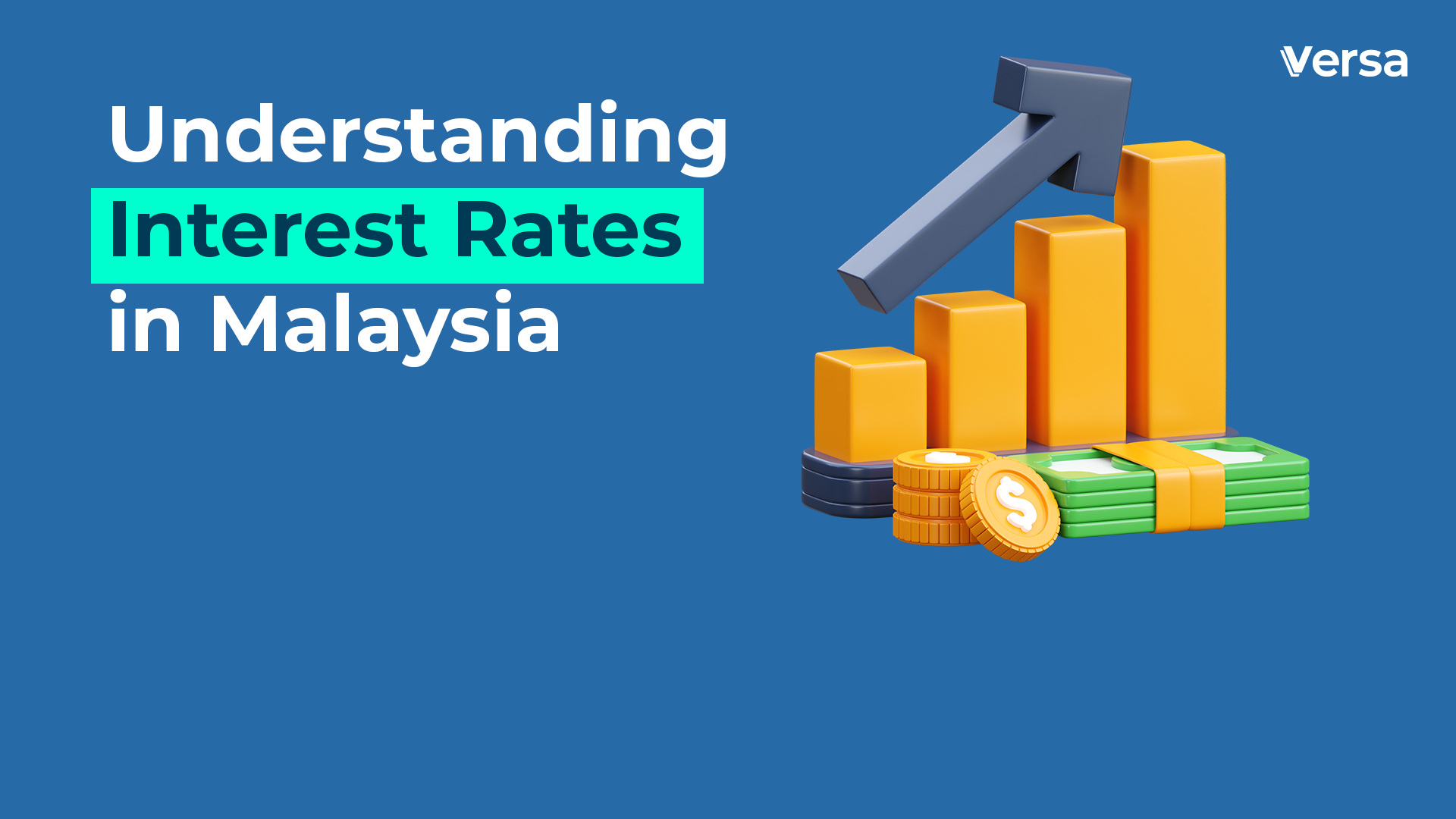
Everything You Need to Know About Interest Rates in Malaysia
- What Are Interest Rates?
- How Are Interest Rates Set in Malaysia?
- The Role of Bank Negara Malaysia
- Types of Interest Rates in Malaysia
- Impact of Interest Rates on the Economy
- How Interest Rates Affect Borrowers and Savers
- Factors That Influence Interest Rates in Malaysia
- Current Interest Rates in Malaysia
- How to Monitor and Compare Interest Rates
- Tips for Managing Your Finances in a Changing Interest Rate Environment
- Build Better Financial Habits with Versa
Interest rates play a pivotal role in shaping Malaysia’s financial landscape, influencing various aspects ranging from personal savings to business investments, including mutual funds and savings accounts.
This article delves into the complexities of interest rates, examining how they are established, the different types available, including short-term and longer-term bonds, and the critical function of Bank Negara Malaysia as the Central Bank. We’ll also address the impact of interest rates on the economy, detailing their effects on both borrowers and savers, as well as the factors that drive fluctuations. You sit back and gain insights on current rates and practical tips for managing finances in this dynamic environment.
What Are Interest Rates?
Interest rates represent the cost of borrowing money or the return on savings, expressed as a percentage of the principal amount. They play a crucial role in influencing economic growth, monetary policy, and the overall financial landscape in Malaysia.
Interest rates can be categorised primarily into nominal and real interest rates.
- The nominal interest rate denotes the stated percentage without adjusting for inflation,
- whereas the real interest rate accounts for the reduction in purchasing power over time.
Understanding these categories is essential, as they significantly impact investment decisions; higher nominal rates may discourage borrowing for businesses while encouraging savings accumulation, while real rates provide insight into true investment returns.
Fluctuations in interest rates directly influence various financial instruments, affecting everything from mortgage loans to bonds and bond prices, impacting capital losses and coupon payments. This dynamic shapes the financial landscape that both individuals and corporations navigate on a daily basis.
Fixed deposits (FDs) are one of the most popular savings options in Malaysia, offering a guaranteed return on investment. Since FDs are typically linked to the prevailing interest rates, understanding these rates is crucial when deciding on the right time to lock in your deposit. Higher interest rates often translate into better returns for fixed deposit holders.

How Are Interest Rates Set in Malaysia?
In Malaysia, interest rates are primarily determined by Bank Negara Malaysia through a comprehensive monetary policy framework that takes into account various economic indicators and market expectations.
This process involves a meticulous analysis of key factors such as inflation rates and the GDP deflator, which provide critical insights into the country’s economic health. The Overnight Policy Rate (OPR) serves as an essential benchmark interest rate, guiding financial institutions and people like you in your borrowing and lending activities, while the GDP deflator provides insights into domestic expenditure.
Changes in the OPR can directly affect other interest rates within the economy, creating a significant ripple effect. By closely monitoring fluctuations in inflation and GDP, including the GDP deflator, Bank Negara can make informed adjustments to the OPR, either stimulating economic growth or curbing inflation, thereby ensuring stability within the financial system.
The Role of Bank Negara Malaysia
Bank Negara Malaysia serves a crucial function as the Central Bank, responsible for establishing monetary policy and regulating interest rates to promote economic stability and growth within the country.
In fulfilling this role, the bank cultivates a robust financial environment that helps mitigate the risks associated with both inflation and deflation. A primary function of this institution is to influence interest rates, which have a direct effect on borrowing and lending practices in the economy.
For instance, during economic downturns, Bank Negara Malaysia may reduce interest rates as a primary policy tool to stimulate spending and investment, thereby encouraging economic growth. Conversely, in response to increasing inflation, the bank might raise interest rates to temper excessive demand.
Furthermore, the bank actively monitors financial conditions and employs various measures, such as adjusting the Statutory Reserve Requirement, to maintain liquidity within the banking system, thereby ensuring that economic activities can continue without disruption.

Types of Interest Rates in Malaysia
Malaysia exhibits a variety of interest rates, including the benchmark interest rate, the Overnight Policy Rate, and rates applicable to both longer-term and short-term bonds. Each of these rates serves distinct purposes within the financial landscape.
These interest rates are pivotal in shaping the economic environment, influencing factors such as borrowing costs and savings yields. For example, the benchmark interest rate directly affects retail loan rates, which in turn impacts your spending and business investments.
Short-term bond rates typically respond swiftly to adjustments in the central bank’s monetary policy, while longer-term rates reflect investor expectations regarding future economic conditions.
Financial analysts closely monitor the yield curve, which illustrates the relationship between interest rates and bond maturities, providing valuable insights into market expectations, economic activity, and potential economic shifts.
A steep yield curve may indicate strong growth expectations, whereas an inverted yield curve often signals concerns about potential recessions, thereby informing investment strategies and risk assessments.
Impact of Interest Rates on the Economy
Interest rates have a significant impact on the economy by influencing investment decisions, domestic expenditure, government plans such as diesel subsidies, and the effects of inflation, thereby shaping overall economic growth and stability in Malaysia.
When interest rates rise, borrowing costs increase, which leads to reduced consumer spending as you become more hesitant about taking out loans for major purchases, such as cars and homes. This cautious attitude often extends to businesses, which may delay or scale back investments due to higher financing costs.
Conversely, lower interest rates typically encourage increased spending and investments, thereby stimulating economic activity. For instance, during the global financial crisis of 2008, Malaysia lowered interest rates to promote growth, resulting in a gradual recovery as consumers and businesses regained confidence.
Consequently, fluctuations in interest rates play a crucial role in guiding economic trends, influencing inflation rates, and determining overall financial health.

How Interest Rates Affect Borrowers and Savers
Interest rates significantly influence both borrowers and savers; lower rates promote borrowing, while higher yields on savings accounts can enhance returns for savers, ultimately affecting their financial decisions.
As interest rates rise, borrowers encounter increased costs for loans, making it more challenging to finance homes, vehicles, or personal projects, impacting their financial situation and credit risk. This change can lead to tighter budgets and more cautious spending, as the financial burden associated with credit becomes heavier.
Conversely, individuals with savings accounts gain from improved yields, which provide a strong incentive to save rather than spend. Higher rates often result in better returns on investment products, enabling savers to grow their wealth more effectively.
For savers, one of the safest and most common ways to benefit from higher interest rates is through fixed deposits. As interest rates rise, fixed deposit accounts offer better returns, making them an attractive option for those looking to grow their savings securely. However, during periods of lower interest rates, FD returns may decrease, prompting savers to explore alternative investments.
Thus, the interplay between saving and borrowing behaviours shapes consumer choices, influencing overall economic growth and stability.
Factors That Influence Interest Rates in Malaysia
Several factors influence interest rates in Malaysia, including inflation, economic growth, government policies—such as diesel subsidies—and the monetary policy established by Bank Negara Malaysia.
Each of these elements plays a crucial role in shaping the broader economic landscape, affecting both consumer behaviour and investment strategies.
For instance, when inflation rises, it typically deteriorates purchasing power, prompting the central bank to adjust rates to maintain economic stability. In contrast, consistent economic growth can lead to an increased demand for loans, subsequently driving rates upward as lenders seek improved returns.
Government subsidies, such as those provided for diesel, create a ripple effect on inflation and spending habits. Financial analysts emphasise the importance of understanding these interconnected factors, including interest rate trends and the effective interest rate, as they collectively determine market dynamics and influence investor confidence and borrowing costs.

Current Interest Rates in Malaysia
According to the latest data, current interest rates in Malaysia, as set by Bank Negara Malaysia, reflect ongoing adjustments in response to inflationary effects and the prevailing financial landscape.
The Overnight Policy Rate (OPR) has recently been adjusted to 3.00%, indicating a cautious approach to maintaining economic stability. This adjustment follows a trend of relatively low interest rates in previous years, including a record low of 1.75% during the pandemic, which was aimed at stimulating economic growth.
The current rates signal a shift towards normalisation as inflationary pressures continue to escalate. In comparison, rates from two years ago were significantly more favourable for borrowing, contributing to increased consumer spending and business investments.
This increase in rates may impact loan affordability and dampen consumption in the short term, prompting stakeholders to reevaluate their financial strategies, considering effective interest rates and interest earned on savings.
How to Monitor and Compare Interest Rates
Monitoring and comparing interest rates is crucial for making informed financial decisions. Utilising resources such as Statista and the World Bank allows you to stay updated on current trends, market expectations, and statistical analysis of the interest rate environment.
Employing a range of online tools, including interest rate comparison websites and financial calculators, can provide valuable insights into the best available options. Staying informed through reliable financial news sources enables a comprehensive understanding of the broader economic factors that influence interest rates.
Additionally, examining databases that offer historical data on various financial instruments assists in quantifying potential returns on investments, such as bonds or savings accounts.
This thorough approach enables you to assess the implications of changing interest rates and to make well-informed decisions aligned with your financial objectives.
Tips for Managing Your Finances in a Changing Interest Rate Environment
In a fluctuating interest rate environment, effectively managing finances requires individuals to adapt their investment strategies, explore various savings options, and comprehend the implications of financial instruments.
It is crucial to remain informed about how changes in interest rates can affect consumer borrowing and investment returns. For example, individuals have been known to consider diversifying their portfolios by incorporating a mix of stocks, bonds, and alternative assets to mitigate market volatility.
In a changing interest rate environment, fixed deposits can be an excellent option for those seeking stability. By locking in your funds at a fixed interest rate, you can safeguard your savings against market volatility.
Evaluating your risk profile can assist in identifying appropriate investment vehicles.
Additionally, optimising savings accounts to take advantage of compounded interest can significantly enhance savings over time. Therefore, it is advisable to regularly compare account options to ensure access to the best available rates.

Meet Versa, a digital wealth management app dedicated to empowering Malaysians from all walks of life to achieve financial wellness.
Our app makes saving and investing simple via its partnership with AHAM Asset Management Berhad (formerly known as Affin Hwang Asset Management), and highly accessible by introducing low entry amounts, low fees and flexibility that allows users to withdraw anytime without incurring penalties.
Versa is registered by the Securities Commission (SC) of Malaysia to operate as a Recognized Marketing Operator (RMO) under guidelines as an E-Services platform.
Download our Versa app today and kickstart your investment game.
Let’s grow your wealth, Versama-sama!

Should you have any questions, please do not hesitate to reach out to us here. 💬
